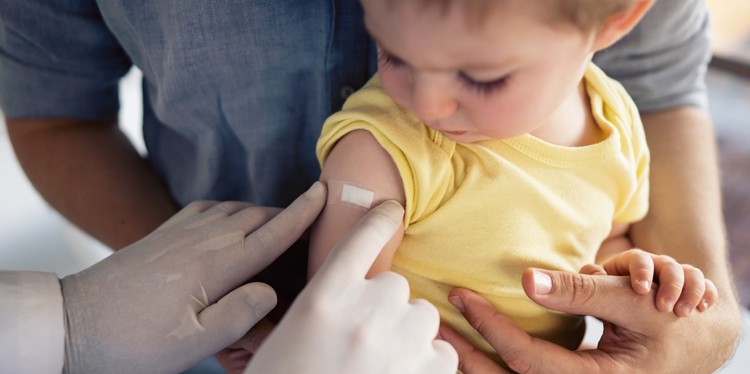Help your child cope with pokes

With the new school year and flu season soon to arrive, caregivers are looking for ways to support their children for positive immunization experiences. As child life specialists, it is our job to help children and families cope with scary, painful, and potentially traumatic experiences—especially at the hospital or clinic.
There are many ways that families can partner with the medical team to assist with anxiety about pokes.
Prepare your child
- Prepare: Remind your child that they have an upcoming vaccination appointment. For younger children (birth to five), this information can be shared that same day. For older children, this information can be shared a day or two before. Despite their age, children deserve the right to know what is happening to their bodies and why it is important. You do not want to surprise them, which can cause medical distrust and fear.
- Educate: Explain to your child why immunizations are important. Clarify that vaccines contain medicine to protect their body from getting really sick. Assure them that vaccines are a way to protect their bodies and their friends and family and are not a punishment for anything that they did wrong.
- Play: Allow children to process the experience ahead of time. Give children a play medical kit and have them practice various scenarios through play. Kids learn and grow through play and fears may commonly come out at this time. You can reassure your child, educate and work with them to develop a coping plan.
Develop a coping plan
There are various tools that can help with pain relief for pokes. Adults should never promise children that the pain will be removed completely, but that the tools can help make it hurt less.
- Sucrose (sugar water) or breastfeeding: For infants, ask about oral sucrose solution or breastfeeding right before and during the poke. The sucking motion is soothing to babies
 and helps to calm them.
and helps to calm them. - Lidocaine cream: For toddlers and older children, topical lidocaine creams covered with a clear bandage (Tegaderm) or plastic wrap can be placed when you arrive at the clinic or put on ahead of time at home. These creams need 45-60 minutes to be effective for pain relief. This cream can be prescribed by your provider or purchased over-the-counter at vendors like Amazon (4% Lidocaine Cream).
- Buzzy®: For children over 12 months, Buzzy® is a vibrating device that “tricks” the brain to focus on vibration instead of the poke. It is placed above the site of the injection, about 30-120 seconds before the shot is given. It can also be combined with lidocaine cream. Buzzy can also be used with ice pack “wings” in children over two. You can have your child play with Buzzy ahead of time so that they are not frightened by the motion or soft buzzing sound when it is used for their shot(s).
- ShotBlocker: The ShotBlocker is also a tool that “tricks” the brain to focus less on the individual poke and, instead, spreads the sensation across a larger surface area of the skin. It can also be used alongside lidocaine cream.
- Comfort positioning: Discuss with your child where they would like to sit for their immunizations. Regardless of age or developmental level, many children would rather sit on a trusted adult’s lap than lie flat on an exam table, surrounded by medical staff. Other children may feel comfortable sitting independently.
- Distraction: Your child can choose to watch the procedure or focus on something else. Brainstorm with your child about possible distraction items to bring along (e.g. iPad, stress balls, iSpy books, bubbles, comfort items, light spinner, etc.).
Support during and after immunizations
- Plan: When you arrive at the appointment, go over your family’s coping plan with the medical team to ensure everyone is on the same page. Get your child seated comfortably and if they choose a in distraction tool, begin using it before to the injection(s). It is okay for them to watch the procedure, especially if it will give your child a sense of control over what is happening.
- One Voice: Limit talking during the injection. Decide on the one person to speak to avoid too many people talking at once. Avoid common sayings such as “be a big boy/girl” or “be brave” or “don’t cry.” Many children show fear through tears and it is a healthy way for them to express themselves. Instead, reassure your child that they are “doing great,” and that you are right there with them!
- Calm: Try to stay calm. Kids often pick up on adult anxiety. The calmer the environment, the less anxious your child will be.
- Praise: Praise your child for at least one thing they did well, even if it was hard for them. Examples include, “You did such a wonderful job sitting on my lap!” or “You took a great deep breath when the nurse told you to!” or “Thank you for telling us how you feel!” This will build confidence for the next medical experience.
- Process: Allow your child to process what happened at home through continued medical play, reading, and discussing their experience.
By collaborating with the medical team, you can help reduce your child’s needle and pain-phobia!
About the authors
 Sara Snuggerud has been a certified child life specialist for six years and has worked in various settings, including a short stint in Cape Town, South Africa. She hopes to improve the care for pediatric patients throughout Hennepin Healthcare.
Sara Snuggerud has been a certified child life specialist for six years and has worked in various settings, including a short stint in Cape Town, South Africa. She hopes to improve the care for pediatric patients throughout Hennepin Healthcare.
Alyson Weiss serves as the Child Life Program Coordinator at Hennepin Healthcare, where she has worked for the last nine years. Prior to her time at Hennepin, she worked as a certified child life specialist at Memorial Sloan-Kettering Cancer Center and as a middle school teacher in New York City.

